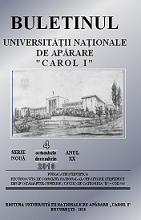NEGOCIERI DIPLOMATICE PENTRU SOLUŢIONAREA CONFLICTULUI TRANSNISTREAN – STUDIU DE CAZ – Partea a II-a –
DIPLOMATIC NEGOTIATIONS FOR SOLVING OF TRANSNISTRIAN CONFLICT - CASE STUDY - 2nd Part -
Author(s): Dan Alexandru Stănescu, Crina Dănăilă, Nicolae - Valentin StănescuSubject(s): Politics / Political Sciences
Published by: Carol I National Defence University Publishing House
Keywords: conflict; strategic balance; military escalation; federalization; independence; separatist movement; secession
Summary/Abstract: The territory between Prut and Nistru had a special importance in the geopolitical and geostrategical plans of Russian or Soviet Empire, russianization of Basarabia being fulfilled with the most brutal methods (wars, forced annexation, dictatorship, prisons, deportations, political police), both during the czarist occupation (1812-1918) and in the soviet period (1940-1941, 1944-1990). Transnistrian conflict had developed typical of what has been defined as „frozen conflict”, following a series of stages: military escalation, foreign intervention, the cessation of fire and create a security zone that would act forces peacekeeping troops composed of the parties to the conflict and Russian troops. During the period that followed cessation of armed conflict occurred more plans of federalization of Moldavia as a single solution out of conflict, none of those not accepted by the authorities from Kishinev. Thus, the sensitive Transnistrian mater raises the same issues: federalization or secession. It may be said that although initially the Transnistrian conflict has been a influence lever for Republic of Moldova, it subsequently became an instrument of Moscow for management of strategic balance in this area, the stakes of conflict beyond the local importance of a region secession to a state.
Journal: Bulletin of "Carol I" National Defence University (EN)
- Issue Year: 2012
- Issue No: 02
- Page Range: 202-226
- Page Count: 25
- Language: Romanian

